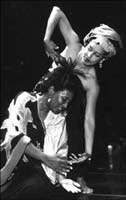

On Eagles' Wings
An International Conference on the
Dynamic Culture of the Yemenite Jews
Miri Hunter Haruach, Ph.D.
When I was younger, I stumbled upon a dance class that was taught by an Israeli
who was playing Middle Eastern music. I was totally mesmerized by the music and the
dance movements that were particular to the Jews of Yemen. Six years later I found myself
presenting at an International Conference on Yemenite Jewry in New York. The
uniqueness of this culture was what led me and 500 other participants to Queens
College for an entire day in August.The conference was co-chaired by Professor Benny Kraut, Director of the Center
for Jewish Studies at Queens College and Professor Nitza Druyan, Professor at
Hofstra University and Chair of the Education Committee for the Yemenite Jewish
Federation of America."On Eagles' Wings" began with opening remarks by the Provost of Queens College,
Professor David Spiedel and General (Reserve) Avigdor Kahalani, former member of
the Knesset and Cabinet of Israel.
The first session, entitled "History, Society and Culture" was highlighted by a
documentary and lecture presented by Professor Druyan. "Yemenite Jews: Images
and Realities" focused on aspects of the lives of Yemenite. There were images of
the religious, social, and ordinary lives of the Yemenite Jews. Perhaps the
most moving part of Professor Druyan's presentation was the telling of the story
of the Yemenite children who were mysteriously lost during the Magic Carpet
airlift. Magic Carpet was the airlift that brought thousands of Jews out of
Yemen and into the new state of Israel in 1948. When the planes landed,
family members were separated and many families were never re-united
with their youngest family members.The next session, "Conflict, Flight and Emigration," featured Reuben Aharoni,
Professor at Ohio State and author of the book "Yemenite Jewry" (Indiana Press,
1986). His talk, "Under Attack: the Jews of Aden, 1947," dealt with the
affluence of the Jews of Aden and their subsequent persecution once Israel
declared statehood. Included in this session was Professor Hayim Tawil of
Yeshiva University; his lecture/presentation, "The Last Exodus from
Yemen," focused on the airlift called Operation Esther.After lunch the conference ran simultaneous sessions: one in English, the other
in Hebrew. The first Hebrew session was Eretz Yisrael and included two papers: "Yemenite
Culture and the Preservation of Jewish Heritage" by Rabbi Dr. Rasson Arussi,
President of Halichot Am Yisrael; and "Yemenite Social Activism" presented by
Yosef Dahoh Halevy, founding editor of Affkim. The second Hebrew session,
"Yemenite Jewry and Torah Study: A Roundtable Discussion," was facilitated by
Professor David Weiss-Halivni of Columbia University.The first English session, entitled "Yemenite Life in Israel," focused on ethnic
neighborhoods in Jerusalem and the Habbani tradition. This first session also
contained a mesmerizing lecture and performance by Shoshana Tubi. She and her
daughter played traditional percussion instruments and sang and danced Yemenite
songs of love, longing and praise to HaShem. Tubi also lectured on the
differences between the song culture of the men and women.The second English session, "Cultural Expressions," began with the singing of
Shabechi Yerushalyim. This was the opening to the presentation I gave which
was entitled "Yemenite Jewish Dance as a Reflection of the Spiritual and
Religious Life." I reviewed the different types and styles of dance
for women and men. I also spoke of my spiritual journey as an African
American into Judaism, which was directly influenced by my cultural awareness
of the Yemenite Jews. I concluded my presentation with a dance of my own
choreography, based on Yemenite dance movements, to a song by Tracy Chapman that
expressed spiritual longing from an African American perspective. My presentation was
followed by two other dancers Zvia Bar and Nava Harari, both former dancers with Israel's
famous Yemenite performance company, Inbal.Lunch and dinner consisted of tradition Yemenite foods and were accompanied
by Yemenite music and dance. Throughout the day there was an art exhibit
featuring the work of Benjamin Levy, Zion Ozeri, Yaelle Ben Zev and Guela
Vardi. In the evening there was a music and dance concert. The event was directed by
Ben Levy and featured Lior Adaki, Sapir Adani, Uri Bitan, Zvia Bar, Orna Berger
and Utzi Cimring. The day of Yemenite culture and Jewish education was ended
with a magical vocal performance by Shimi Tavori.All of the participants funneled out of the LeFrak Concert Hall in deep
conversation and discourse in regards to the conference. For someone like me,
this was an opportunity to be a part of a unique experience. It is only by
learning and experiencing a culture different that one learns to love and not to
fear what is different. Much praise and thanks to Professors Kraut and Druyan
for their wonderful work in putting together and day of heartfelt understanding.
Miri Hunter Haruach is a Jewish educator and activist in the San Francisco Bay area community, as well as a singer, dancer, musician, composer, playwright and scholar. She received a master's degree in directing from the University of New Mexico. Her graduate work focused on the Queen of Sheba.[home] [org] [news] [calendar] [membership] [links] [past] [poetry]